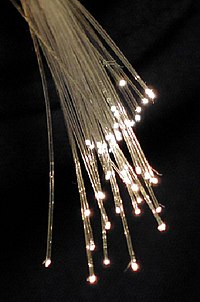
Photo from wikipedia
This paper reveals the role of interfacial rigidity in a fiber reinforced polymer (FRP) composite to crack propagation path and its reinforcement, investigated by simulating a plane-strain model – containing… Click to show full abstract
This paper reveals the role of interfacial rigidity in a fiber reinforced polymer (FRP) composite to crack propagation path and its reinforcement, investigated by simulating a plane-strain model – containing the matrix with a fiber inclusion – loaded transversely. Two fibers, i.e. carbon fiber and glass fiber, were examined. The interface between fiber and matrix was pre-defined using the spring model characterized by a stiffness parameter. A range of interfacial stiffness values from infinity (rigid bonding) to low stiffness were carefully investigated. The results suggested that direction of crack propagations inclined to approach the fiber when the interfacial stiffness was low, even if the fiber had much higher elastic modulus than the matrix – this finding is in contrast to the inclusion theory that merely considers rigid bonding interface. It also suggests that there existed a transition region in which the crack propagation path was altered, from approaching to avoiding the fiber. The region occurred when the interfacial stiffness was in the range between 105 and 106 MPa/mm, within which mechanical properties of the model were recorded to vary notably
Journal Title: Fibers and Polymers
Year Published: 2018
Link to full text (if available)
Share on Social Media: Sign Up to like & get
recommendations!